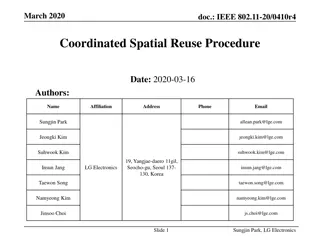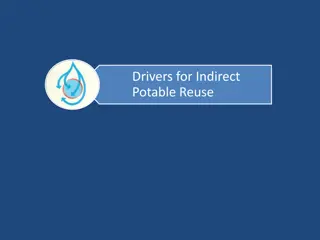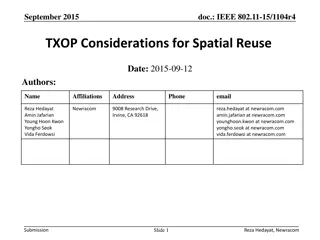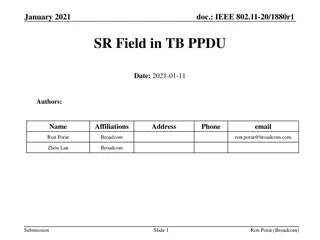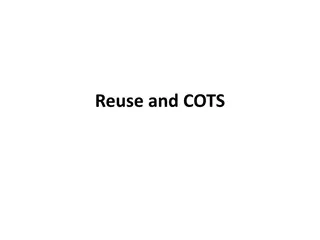Interface Types and Algorithm Reuse
Learn how interface types can simplify algorithm reuse in Java programming. Explore the concept of defining interface types and implementing reusable methods. Understand the differences between classes and interfaces, and see examples of declaring and using interfaces effectively.
Uploaded on Mar 20, 2025 | 1 Views
Download Presentation

Please find below an Image/Link to download the presentation.
The content on the website is provided AS IS for your information and personal use only. It may not be sold, licensed, or shared on other websites without obtaining consent from the author.If you encounter any issues during the download, it is possible that the publisher has removed the file from their server.
You are allowed to download the files provided on this website for personal or commercial use, subject to the condition that they are used lawfully. All files are the property of their respective owners.
The content on the website is provided AS IS for your information and personal use only. It may not be sold, licensed, or shared on other websites without obtaining consent from the author.
E N D
Presentation Transcript
Chapter Goals To be able to declare and use interface types To appreciate how interfaces can be used to decouple classes To learn how to implement helper classes as inner classes To implement event listeners in graphical applications
Using Interfaces for Algorithm Reuse Interface types are used to express common operations. Interfaces make it possible to make a service available to a wide set. This restaurant is willing to serve anyone who conforms to the Customer interface with eat and pay methods.
Defining an Interface Type Example: a method to compute the average of an array of Objects The algorithm for computing the average is the same in all cases Details of measurement differ Goal: write one method that provides this service. We can't call getBalance in one case and getArea in another. Solution: all object who want this service must agree on a getMeasure method BankAccount's getMeasure will return the balance Country's getMeasure will return the area Now we implement a single average method that computes the sum: sum = sum + obj.getMeasure();
Defining an Interface Type Problem: we need to declare a type for obj Need to invent a new type that describes any class whose objects can be measured. An interface type is used to specify required operations (like getMeasure): public interface Measurable { double getMeasure(); } A Java interface type declares methods but does not provide their implementations.
Defining an Interface Type An interface type is similar to a class. Differences between classes and interfaces: An interface type does not have instance variables. All methods in an interface type are abstract (or in Java 8, static or default) They have a name, parameters, and a return type, but no implementation. All methods in an interface type are automatically public. An interface type has no constructor. You cannot construct objects of an interface type.
Defining an Interface Type Implementing a reusable average method: public static double average(Measurable[] objects) { double sum = 0; for (Measurable obj : objects) { sum = sum + obj.getMeasure(); } if (objects.length > 0) { return sum / objects.length; } else { return 0; } } This method is can be used for objects of any class that conforms to the Measurable type. This stand-mixer provides the rotation service to any attachment that conforms to a common interface. Similarly, the average method at the end of this section works with any class that implements a common interface.
Implementing an Interface Type Use implements reserved word to indicate that a class implements an interface type: public class BankAccount implements Measurable { ... public double getMeasure() { return balance; } } BankAccount objects are instances of the Measurable type: Measurable obj = new BankAccount(); // OK
Implementing an Interface Type A variable of type Measurable holds a reference to an object of some class that implements the Measurable interface. Country class can also implement the Measurable interface: public class Country implements Measurable { public double getMeasure() { return area; } . . . } Use interface types to make code more reusable.
Implementing an Interface Type Put the average method in a class - say Data Figure 1 UML Diagram of the Data Class and the Classes that Implement the Measurable Interface Data class is decoupled from the BankAccount and Country classes.
section_1/Data.java 1 public class Data 2 { 3 /** 4 Computes the average of the measures of the given objects. 5 @param objects an array of Measurable objects 6 @return the average of the measures 7 */ 8 public static double average(Measurable[] objects) 9 { 10 double sum = 0; 11 for (Measurable obj : objects) 12 { 13 sum = sum + obj.getMeasure(); 14 } 15 if (objects.length > 0) { return sum / objects.length; } 16 else { return 0; } 17 } 18 }
section_1/MeasurableTester.java 1 2 3 4 public class MeasurableTester 5 { 6 public static void main(String[] args) 7 { 8 Measurable[] accounts = new Measurable[3]; 9 accounts[0] = new BankAccount(0); 10 accounts[1] = new BankAccount(10000); 11 accounts[2] = new BankAccount(2000); 12 13 14 15 16 17 18 19 20 21 22 23 24 25 26 } /** This program demonstrates the measurable BankAccount and Country classes. */ double averageBalance = Data.average(accounts); System.out.println("Average balance: " + averageBalance); System.out.println("Expected: 4000"); Measurable[] countries = new Measurable[3]; countries[0] = new Country("Uruguay", 176220); countries[1] = new Country("Thailand", 513120); countries[2] = new Country("Belgium", 30510); double averageArea = Data.average(countries); System.out.println("Average area: " + averageArea); System.out.println("Expected: 239950"); } Program Run: Average balance: 4000 Expected: 4000 Average area: 239950 Expected: 239950
Comparing Interfaces and Inheritance Here is a different interface: Named public interface Named { String getName(); } A class can implement more than one interface: public class Country implements Measurable, Named A class can only extend (inherit from) a single superclass. An interface specifies the behavior that an implementing class should supply (in Java 8, an interface can now supply a default implementation). A superclass provides some implementation that a subclass inherits. Develop interfaces when you have code that processes objects of different classes in a common way.
Self Check 10.1 Suppose you want to use the average method to find the average salary of an array of Employee objects. What condition must the Employee class fulfill? Answer: It must implement the Measurable interface, and its getMeasure method must return the salary.
Self Check 10.2 Why can t the average method have a parameter variable of type Object[]? Answer: The Object class doesn't have a getMeasure method, and the average method invokes the getMeasure method.
Self Check 10.3 Why can t you use the average method to find the average length of String objects? Answer: You cannot modify the String class to implement Measurable String is a library class.
Self Check 10.4 What is wrong with this code? Measurable meas = new Measurable(); System.out.println(meas.getMeasure()); Answer: Measurable is not a class. You cannot construct objects of type Measurable.
Self Check 10.5 What is wrong with this code? Measurable meas = new Country("Uruguay", 176220); System.out.println(meas.getName()); Answer: The variable meas is of type Measurable, and that type has no getName method.
Converting From Classes to Interfaces You can convert from a class type to an interface type, provided the class implements the interface. A Measurable variable can refer to an object of the BankAccount class because BankAccount implements the Measurable interface: BankAccount account = new BankAccount(1000); Measurable meas = account; // OK A Measurable variable can refer to an object of the Country class because that class also implements the Measurable interface: Country uruguay = new Country("Uruguay", 176220); Measurable meas = uruguay; // Also OK A Measurable variable cannot refer to an object of the Rectangle class because Rectangle doesn't implement Measurable: Measurable meas = new Rectangle(5, 10, 20, 30); // ERROR
Variables of Class and InterfaceTypes Figure 2 Two references to the same object Figure 3 An Interface Reference Can Refer to an Object of Any Class that Implements the Interface Method calls on an interface reference are polymorphic. The appropriate method is determined at run time.
Casting from Interfaces to Classes Method to return the object with the largest measure: public static Measurable larger(Measurable obj1, Measurable obj2) { if (obj1.getMeasure() > obj2.getMeasure()) { return obj1; } else { return obj2; } } Returns the object with the larger measure, as a Measurable reference. Country uruguay = new Country("Uruguay", 176220); Country thailand = new Country("Thailand", 513120); Measurable max = larger(uruguay, thailand);
Casting from Interfaces to Classes You know that max refers to a Country object, but the compiler does not. Solution: cast Country maxCountry = (Country) max; String name = maxCountry.getName(); You need a cast to convert from an interface type to a class type. If you are wrong and max doesn't refer to a Country object, the program throws an exception at runtime. If a Person object is actually a Superhero, you need a cast before you can apply any Superhero methods.
Self Check 10.6 Can you use a cast (BankAccount) meas to convert a Measurable variable meas to a BankAccount reference? Answer: Only if meas actually refers to a BankAccount object.
Self Check 10.7 If both BankAccount and Country implement the Measurable interface, can a Country reference be converted to a BankAccount reference? Answer: No a Country reference can be converted to a Measurable reference, but if you attempt to cast that reference to a BankAccount, an exception occurs.
Self Check 10.8 Why is it impossible to construct a Measurable object? Answer: Measurable is an interface. Interfaces have no instance variables and no method implementations.
Self Check 10.9 Why can you nevertheless declare a variable whose type is Measurable? Answer: That variable never refers to a Measurable object. It refers to an object of some class a class that implements the Measurable interface.
Self Check 10.10 What does this code fragment print? Why is this an example of polymorphism? Measurable[] data = { new BankAccount(10000), new Country("Belgium", 30510) }; System.out.println(average(data)); Answer: The code fragment prints 20255. The average method calls getMeasure on each object in the array. In the first call, the object is a BankAccount. In the second call, the object is a Country. A different getMeasure method is called in each case. The first call returns the account balance, the second one the area, which are then averaged.
The Comparable Interface Comparable interface is in the standard Java library. Comparable interface has a single method: public interface Comparable { int compareTo(Object otherObject); } The call to the method: a.compareTo(b) The compareTo method returns: a negative number if a should come before b, zero if a and b are the same a positive number if b should come before a. Implement the Comparable interface so that objects of your class can be compared, for example, in a sort method.
The Comparable Interface BankAccount class' implementation of Comparable: public class BankAccount implements Comparable { . . . public int compareTo(Object otherObject) { BankAccount other = (BankAccount) otherObject; if (balance < other.balance) { return -1; } if (balance > other.balance) { return 1; } return 0; } . . . } compareTo method has a parameter of reference type Object To get a BankAccount reference: BankAccount other = (BankAccount) otherObject;
The Comparable Interface Because the BankAccount class implements the Comparable interface, you can sort an array of bank accounts with the Arrays.sort method: BankAccount[] accounts = new BankAccount[3]; accounts[0] = new BankAccount(10000); accounts[1] = new BankAccount(0); accounts[2] = new BankAccount(2000); Arrays.sort(accounts); Now the accounts array is sorted by increasing balance. The compareTo method checks whether another object is larger or smaller.
Self Check 10.11 How can you sort an array of Country objects by increasing area? Answer: Have the Country class implement the Comparable interface, as shown below, and call Arrays.sort. public class Country implements Comparable { . . . public int compareTo(Object otherObject) { Country other = (Country) otherObject; if (area < other.area) { return -1; } if (area > other.area) { return 1; } return 0; } }
Self Check 10.12 Can you use the Arrays.sort method to sort an array of String objects? Check the API documentation for the String class. Answer: Yes, you can, because String implements the Comparable interface type.
Self Check 10.13 Can you use the Arrays.sort method to sort an array of Rectangle objects? Check the API documentation for the Rectangle class. Answer: No. The Rectangle class does not implement the Comparable interface.
Self Check 10.14 Write a method max that finds the larger of any two Comparable objects. Answer: public static Comparable max(Comparable a, Comparable b) { if (a.compareTo(b) > 0) { return a; } else { return b; } }
Self Check 10.15 Write a call to the method of Self Check 14 that computes the larger of two bank accounts, then prints its balance. Answer: BankAccount larger = (BankAccount) max(first, second); System.out.println(larger.getBalance()); Note that the result must be cast from Comparable to BankAccount so that you can invoke the getBalance method.
Using Interfaces for Callbacks Limitations of Measurable interface: Can add Measurable interface only to classes under your control Can measure an object in only one way E.g., cannot analyze a set of cars by both speed and price Callback: a mechanism for specifying code that is executed at a later time. Problem: the responsibility of measuring lies with the added objects themselves. Alternative: give the average method both the data to be averaged and a method of measuring. Create an interface: public interface Measurer { double measure(Object anObject); } All objects can be converted to Object.
Using Interfaces for Callbacks The code that makes the call to the callback receives an object of class that implements this interface: public static double average(Object[] objects, Measurer meas) { double sum = 0; for (Object obj : objects) { sum = sum + meas.measure(obj); } if (objects.length > 0) { return sum / objects.length; } else { return 0; } } The average method simply makes a callback to the measure method whenever it needs to measure any object.
Using Interfaces for Callbacks A specific callback is obtained by implementing the Measurer interface: public class AreaMeasurer implements Measurer { public double measure(Object anObject) { Rectangle aRectangle = (Rectangle) anObject; double area = aRectangle.getWidth() * aRectangle.getHeight(); return area; } } Must cast from Object to Rectangle: Rectangle aRectangle = (Rectangle) anObject;
Using Interfaces for Callbacks To compute the average area of rectangles: construct an object of the AreaMeasurer class and pass it to the average method: Measurer areaMeas = new AreaMeasurer(); Rectangle[] rects = { new Rectangle(5, 10, 20, 30), new Rectangle(10, 20, 30, 40) }; double averageArea = average(rects, areaMeas); The average method will ask the AreaMeasurer object to measure the rectangles.
Using Interfaces for Callbacks The Data class (which holds the average method) is decoupled from the class whose objects it processes (Rectangle). You provide a small helper class AreaMeasurer, to process rectangles. Figure 6 UML Diagram of the Data Class and the Measurer Interface
section_4/Measurer.java 1 2 3 4 public interface Measurer 5 { 6 /** 7 Computes the measure of anobject. 8 @param anObject the object to be measured 9 @returnthe measure 10 */ 11 double measure(Object anObject); 12 } /** Describes any class whose objects can measure other objects. */
section_4/AreaMeasurer.java 1 import java.awt.Rectangle; 2 3 /** 4 Objects of this class measure rectangles by area. 5 */ 6 public class AreaMeasurer implements Measurer 7 { 8 public double measure(Object anObject) 9 { 10 Rectangle aRectangle = (Rectangle) anObject; 11 double area = aRectangle.getWidth() * aRectangle.getHeight(); 12 return area; 13 } 14 }
section_4/Data.java 1 public class Data 2 { 3 /** 4 Computes the average of the measures of the given objects. 5 @param objects an array of objects 6 @param meas the measurer for the objects 7 @return the average of the measures 8 */ 9 public static double average(Object[] objects, Measurer meas) 10 { 11 double sum = 0; 12 for (Object obj : objects) 13 { 14 sum = sum + meas.measure(obj); 15 } 16 if (objects.length > 0) { return sum / objects.length; } 17 else { return 0; } 18 } 19 }
section_4/MeasurerTester.java 1 import java.awt.Rectangle; 2 3 /** 4 This program demonstrates the use of aMeasurer. 5 */ 6 public class MeasurerTester 7 { 8 public static void main(String[] args) 9 { 10 Measurer areaMeas = new AreaMeasurer(); 11 12 13 14 15 16 17 18 19 20 21 22 23 } Rectangle[] rects = new Rectangle[] { new Rectangle(5, 10, 20, 30), new Rectangle(10, 20, 30, 40), new Rectangle(20, 30, 5, 15) }; double areaMeas); averageArea); 625"); averageArea System.out.println("Average area: " + System.out.println("Expected: = Data.average(rects, } Program Run: Average area: 625 Expected: 625
Self Check 10.16 Suppose you want to use the average method of Section 10.1 to find the average length of String objects. Why can t this work? Answer: The String class doesn't implement the Measurable interface.
Self Check 10.17 How can you use the average method of this section to find the average length of String objects? Answer: Implement a class StringMeasurer that implements the Measurer interface.
Self Check 10.18 Why does the measure method of the Measurer interface have one more argument than the getMeasure method of the Measurable interface? Answer: A measurer measures an object, whereas getMeasure measures itself , that is, the implicit parameter.
Self Check 10.19 Write a method max with three arguments that finds the larger of any two objects, using a Measurer to compare them. Answer: public static Object max(Object a, Object b, Measurer m) { if (m.getMeasure(a) > m.getMeasure(b)) { return a; } else { return b; } }




